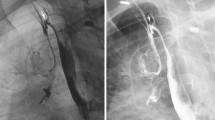Abstract
Narrowing of the esophageal lumen often exists for months before being noted by the patient. Screening tests for such lesions would be useful, if applicable to office use. A magnetic disc tablet (14 mm in diameter and 5 mm thick) was fashioned by hand using dental acrylic material to enclose the magnet with a smooth watertight sheath. A magnetic detector was held on the anterior abdominal wall 2.5 cm below the xiphoid cartilage and 2.5 cm to its left. A significant change in reading indicated that the tablet had reached the cardia of the stomach. The magnetic tablet was readily detected in 11 patients without organic narrowing. Our method attempts to detect narrowing of the esophageal lumen by use of a magnetic disc tablet. Perhaps this will be of clinical usefulness in detecting esophageal disease before symptoms become apparent.
Similar content being viewed by others
REFERENCES
Bennett JR, Castell DO: Overview and symptom assessment. In The Esophagus, 2nd ed. DO Castell (ed). Boston, Little, Brown, 1995, pp 29–39
DeVault KR: Lower esophageal (Schatzki's) ring: pathogenesis, diagnosis and therapy. Dig Dis 14:323–329, 1996
vanWesten D, Ekberg O: Solid bolus swallowing in the radiologic evaluation of dysphagia. Acta Radiol 34:372–375, 1993
Ghahremani GG, Weingardt JP, Curtin KR, Yaghmai V: Detection of occult esophageal narrowing with a barium tablet during chest radiography. Clin Imaging 20:184–190, 1996
Devesa SS, Blot WJ, Fraumeni JF Jr: Changing patterns in the incidence of esophageal and gastric carcinoma in the United States. Cancer 83:2049–2053, 1998
Corley DA, Levin TR, Habel LA, Weiss NS, Buffler PA: Surveillance and survival in Barrett's adenocarcinomas: a population-based study. Gastroenterology 122:633–640, 2002
Dulai GS: Surveying the Case for Surveillance. Gastroenterology 122:820–823, 2002
Wenger J, Allee JG, Landy MS: Magnet-tipped tubes for studies of the stomach and duodenum. Am J Dig Dis 15:383–393, 1970
Curtis DJ, Cruess DF, Willgress ER: Abnormal solid bolus swallowing in the erect position. Dysphagia 2:46–49, 1987
Gallo SH, McClave SA, Makk LJ, Looney SW: Standardization of clinical criteria required for use of the 12.5 millimeter barium tablet in evaluating esophageal luminal patency. Gastrointest Endosc 44:181–184, 1996
Pignone M, Rich M, Teutsch SM, Berg AO, Lohr KN: Screening for colorectal cancer in adults at average risk: A summary of the evidence for the U.S. Preventive Services Task Force. Ann Intern Med 137:132–141, 2002
Webb WA: Management of foreign bodies of the upper gastrointestinal tract. Gastroenterology 94:204–216, 1988
Author information
Authors and Affiliations
Rights and permissions
About this article
Cite this article
Wenger, J., Jackson, R.E. & Norman, S. Screening for Esophageal Luminal Narrowing—A Magnetic Disc Tablet as a Bolus Challenge: Preliminary Report. Dig Dis Sci 49, 157–160 (2004). https://doi.org/10.1023/B:DDAS.0000011619.11915.d7
Issue Date:
DOI: https://doi.org/10.1023/B:DDAS.0000011619.11915.d7




